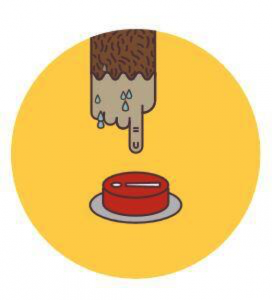My manager had a genuine smile when she said it.
“You’re going to take over the newsletter starting next week.”
I logged into Mailchimp and looked at the number of subscriptions again.
30,000 people.
Crap.
This was month three at my first job out of college and I had only recently started to take over our social media accounts, which were half the newsletter audience size. The newsletter was much more permanent and personal than tweets or Facebook posts, which may or may not get seen in a packed feed. They landed directly into people’s sacred inboxes, to be opened at their leisure; I had much less control once it was sent out.
Though my journalism background helped immensely, every Tuesday and Thursday morning (newsletter send out days), my heart rate would go up. I would start to sweat through my shirt as my mouse hovered over the Mailchimp monkey’s nervous, shaky hand animation above the send button.

Mailchimp, if you’re reading this, might you consider an animation that doesn’t remind the sender of their own anxiety and instead, something that implies they are going to spread awesomeness to thousands of inboxes?
Newsletter Ideas: What makes a Good Newsletter
In the beginning, I struggled with our newsletter. The copy was clunky as a result of trying to fit in too many messages. I wasn’t connecting deeply with our audience. The 5-person editing process also didn’t help — too much conflicting feedback — so we reduced this down to one, sometimes two editors.
One day one of my co-workers let me know the newsletter had the wrong link for one of our most important events. I excused myself to the bathroom and cried.
This, ladies and gents, was my breaking point.
I wish I could say that after this point, I made all of the improvements listed below to our newsletter right away.
It didn’t happen that fast, but I’m proud to say that a year in a half later the newsletter is a project I’m proud to own, one that I’ve been recognized for publicly on Twitter and one that has positively re-engaged our community. Our subscription list reversed from a slow decrease to surpassing the number it was when I first started; and open and click rates have both jumped up significantly in the last year. It’s become a good newsletter.
And though there is reason to celebrate the growth, there’s always room for improvement. I’ll be the first to admit the design could use an update and “hidden” could be used to describe our newsletter sign up form.
That said, I still thought it would be valuable to highlight the changes that have worked for us and explain why they’re working. These are some of the things I’ve learned about how to increase engagement and get your audience to actually look forward to opening your newsletter.
Subject lines
Subject lines.
These 3-10 word structures are arguably the most important part of the entire newsletter. If your subject line is not engaging, you risk losing hundreds or thousands of eyes and thus risk wasted time and resources.
With so many subject lines competing in an inbox, it can be tough to get yours to stand out. Here are some strategies that worked for us.
Provide Solutions to Pain Points
If you want to get more and more of your audience to open your newsletter, spend lots of time reviewing who your audience is, what is important to them and what their pain points are.
Some tips for identifying their pain points:
- Talk to them at events (best by far)
- Talk to them online
- Listen to them online
Get in the circles that they’re in – this means a lot of deep net surfing following their likes/concerns/sites they’re suggesting and reading.
Once you’ve identified some major pain points, address a positive solution for them in your subject lines. If you have a niche audience, this might be easier.
The majority of our audience are founders, and as a result, one of their biggest pain points is getting funding. Here’s the subject lines of our emails lines that had the highest open rates:
Verizon Has Money for Innovators
You Need Funding. We Have Investors For You
How to Get 200k Users Without Spending a Dime
Save your subject line for last
I tend to save subject lines for last. For me, this made it easier to write after seeing all of the content pulled together in the newsletter. There should be a flow and obvious connection between the subject line and the content inside of the newsletter. For any journalists out there, consider the subject line the lead and the content inside “above the fold,” the nut graph.
Deks
This is the name we use to refer to the preheader — that’s the gray lettering that appears next to the black subject line in your inbox. It’s easy to overlook, but if used effectively can definitely help the open rate.
In our editorial newsletter, we changed the dek to say “Last week’s most read.”
Whatever you write in gray, give some extra thought about how it can support the subject line.
Main Copy
The body of an email is a great place to break down barriers and humanize your brand. For Women 2.0, it was important that the messaging was empowering and optimistic and spoke to CEOs – the role the majority of our audience was aspiring to be.
Our voice was not always conveyed in 8-12 sentence intros. We realized we needed to trim down our intros significantly in our events newsletter and replaced the intro with a one-sentence teaser for our featured article in our editorial newsletter.
With shorter intros, click rates went up and it freed me to work on other parts of the newsletter.
TLDR; Simplify your copy.
Look to other newsletters for inspiration and new creative styles
Search for newsletters that have a good track record and sign up for them. Print out the ones you like and highlight or circle what you like about them. Then keep an email folder of them so you can refer to those components you like, and mimic them in your own newsletter.
I read these newsletters for inspiration:
- Eat 24
- Uber
- the 99U team
- CMX
- General Assembly
- the Skimm
- Medium Daily Digest
- First Round Review
- GoodReads
- Muck Rack Daily
- The Broadsheet
All of them serve different communities and various needs. By following a variety of newsletters, I see and compare how each of them take on and communicate their products, deals, sales and how they leverage their community.
Highlight your community
There were two things I really liked from the newsletters I studied: when newsletters incorporated inspirational quotes and when they showcased different individuals in their community. I gave this some thought and realized I could marry the two by quoting our audience, writers and speakers who could provide more meaningful inspiration than a quote from a famous person.
I began incorporating these inspirational quotes in a “Women 2.0 Soundbites” section which was placed at the footer of our newsletter. It contributed to the “optimistic” fulfillment of our brand voice and gave our audience a name and face of someone in our community to connect with who may be going through a similar experience.
And after all, that’s what good newsletters do, right? They create and enhance community; educate, excite people and make them smile or wonder and take action.
The newsletter is an experience, not a sales pitch. It’s where the “why” of the brand should be expressed, through design and copy; the “what” should be secondary.
Newsletters are ultimately a huge part in how brands communicate today – and cheaply! They are a body of thoughtful copy and design and animation – should I go so far as to say pieces of art?
They’re what many of my fellow tech peers read on their lunch break and the first thing they read in the morning – new versions of daily newspapers if you will, for better or worse, – and that’s a powerful thing. Let’s make it worth their while.




